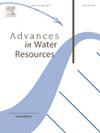Inferring experimental colloid removal with an inverse two-population model linking continuum scale data to nanoscale features
IF 4
2区 环境科学与生态学
Q1 WATER RESOURCES
引用次数: 0
Abstract
Models of colloid transport in porous media that assume constant fractional loss per grain passed fail in the presence of repulsive barriers to attachment, under which condition experiments produce profiles of colloid concentrations with distance from source that are nonexponential. Nonexponential removal is hypothesized to arise from variable likelihood of encountering nanoscale regions of attraction (heterodomains) on grain surfaces that allow attachment. Implementing heterodomains in mechanistic simulations of pore scale trajectories generates continuum-scale rate coefficients that produce experimentally-observed breakthrough-elution curves (BTEC) and retention profiles (RP). However, current one-directional simulation across scales is inefficient in finding a heterodomain surface coverage that yields observed RP and BTEC. In this work, we develop an inverse two-population model approach that not only estimates colloid rate coefficients from experimental BTEC and RP data but also quantifies the associated uncertainty, thereby allowing the problem to be worked from both ends via comparison of (1) rate coefficients upscaled from mechanistic pore scale simulations incorporating heterodomains with (2) rate coefficients inverted from continuum-scale BTEC and RP. We validate our inverse model using synthetic data with known removal rates and subsequently demonstrate its applicability to experimental data with multiexponential and nonmonotonic RPs. We moreover derive what is likely the first analytical expression for the RP under repulsive conditions, revealing that the hypoexponential distribution can be used to reproduce multiexponential and non-monotonic shapes. By addressing key limitations in present models, our inverse approach offers a valuable tool for advancing colloidal transport predictions in natural environments.
用连接连续尺度数据和纳米尺度特征的逆双种群模型推断实验胶体去除
多孔介质中胶体输运模型假设每粒颗粒通过的分数损失恒定,但由于存在排斥性屏障而无法实现吸附,在这种情况下,实验得出的胶体浓度随距离源的距离呈非指数分布。假设非指数去除是由于在晶粒表面上遇到纳米级吸引区域(异质畴)的可能性不同而产生的,这些区域允许附着。在孔隙尺度轨迹的机制模拟中实现异质域,可以产生连续尺度的速率系数,从而产生实验观察到的突破-洗脱曲线(BTEC)和保留曲线(RP)。然而,目前的跨尺度单向模拟在寻找产生观察到的RP和BTEC的异质域表面覆盖方面效率低下。在这项工作中,我们开发了一种逆双种群模型方法,不仅可以从实验BTEC和RP数据中估计胶体速率系数,还可以量化相关的不确定性,从而允许通过比较(1)从包含异质域的机械孔隙尺度模拟中升级的速率系数与(2)从连续尺度BTEC和RP中反转的速率系数,从两个方面来解决问题。我们使用具有已知去除率的合成数据验证了我们的逆模型,并随后证明了其对具有多指数和非单调rp的实验数据的适用性。此外,我们还推导了在排斥条件下RP的可能的第一个解析表达式,揭示了次指数分布可用于再现多指数和非单调形状。通过解决当前模型的关键限制,我们的逆方法为推进自然环境中的胶体输运预测提供了一个有价值的工具。
本文章由计算机程序翻译,如有差异,请以英文原文为准。
求助全文
约1分钟内获得全文
求助全文
来源期刊

Advances in Water Resources
环境科学-水资源
CiteScore
9.40
自引率
6.40%
发文量
171
审稿时长
36 days
期刊介绍:
Advances in Water Resources provides a forum for the presentation of fundamental scientific advances in the understanding of water resources systems. The scope of Advances in Water Resources includes any combination of theoretical, computational, and experimental approaches used to advance fundamental understanding of surface or subsurface water resources systems or the interaction of these systems with the atmosphere, geosphere, biosphere, and human societies. Manuscripts involving case studies that do not attempt to reach broader conclusions, research on engineering design, applied hydraulics, or water quality and treatment, as well as applications of existing knowledge that do not advance fundamental understanding of hydrological processes, are not appropriate for Advances in Water Resources.
Examples of appropriate topical areas that will be considered include the following:
• Surface and subsurface hydrology
• Hydrometeorology
• Environmental fluid dynamics
• Ecohydrology and ecohydrodynamics
• Multiphase transport phenomena in porous media
• Fluid flow and species transport and reaction processes
 求助内容:
求助内容: 应助结果提醒方式:
应助结果提醒方式:


